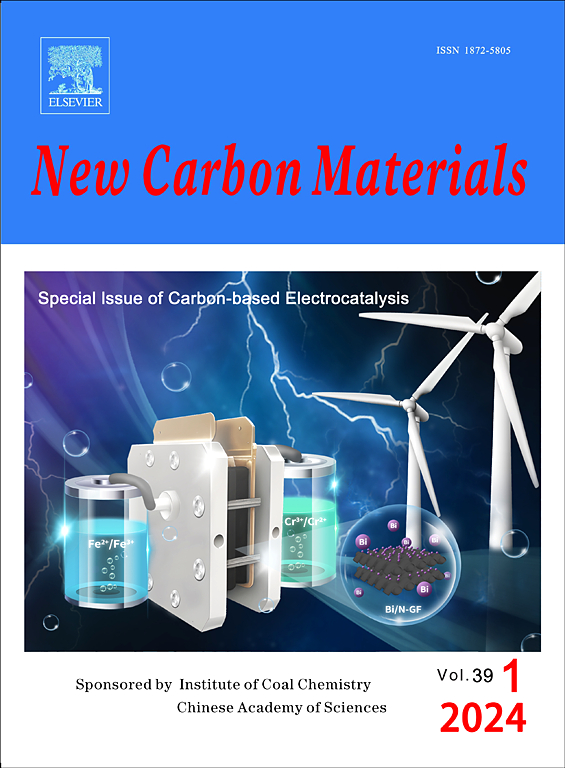The use of an oxidized carbon nanotube film to control Zn deposition and eliminate dendrite formation in a Zn ion battery
IF 5.7
3区 材料科学
Q2 Materials Science
引用次数: 0
Abstract
Aqueous zinc ion batteries are regarded as one of the most promising candidates for large-scale energy storage due to their high safety, cost-effectiveness, and environmental friendliness. However, uncontrolled zinc dendrite growth and side reactions of the zinc anode decrease the stability of Zn batteries. We report the synthesis of an air-oxidized carbon nanotube (O-CNT) film by chemical vapor deposition followed by heat treatment in air which is used as a protective layer on the Zn foil to suppress zinc dendrite growth. The increase in the hydrophilicity of the O-CNT film caused by air oxidation facilitates zinc deposition between the film and the anode instead of deposition on the film surface. The porous structure of the O-CNT film homogenizes the Zn2+ ion flux and the electric field on the surface of the Zn foil, leading to the uniform deposition of Zn. As a result, a O-CNT@Zn symmetric cell has a much better cycling stability with a life of more than 3000 h at 1 mA cm−2 with a capacity of 1 mAh cm−2, and values of more than 2000 h and 1 mAh cm−2 at 5 mA cm−2. In addition, a O-CNT@Zn || Mn2+ inserted hydrated vanadium pentoxide (MnVOH) full cell has a better rate performance than a Zn || MnVOH cell, achieving a high discharge capacity of 194 mAh g−1 at a high current density of 8 A g−1. In a long-term cycling test, the O-CNT@Zn || MnVOH full cell has a capacity retention of 58.8% after 2000 cycles at a current density of 5 A·g−1.
- Download: Download high-res image (102KB)
- Download: Download full-size image
利用氧化碳纳米管薄膜控制锌离子电池中锌的沉积和消除枝晶的形成
水锌离子电池因其高安全性、高成本效益和环境友好性被认为是大规模储能最有前途的候选者之一。然而,锌枝晶生长不受控制和锌阳极的副反应降低了锌电池的稳定性。采用化学气相沉积和空气热处理的方法合成了一种空气氧化碳纳米管(O-CNT)薄膜,该薄膜用作锌箔的保护层以抑制锌枝晶的生长。空气氧化导致O-CNT膜亲水性提高,有利于锌在膜与阳极之间沉积,而不是沉积在膜表面。O-CNT薄膜的多孔结构使锌箔表面的Zn2+离子通量和电场均匀化,从而使锌的沉积均匀。因此,O-CNT@Zn对称电池具有更好的循环稳定性,在1ma cm - 2时的寿命超过3000小时,容量为1mah cm - 2,在5ma cm - 2时的值超过2000小时和1mah cm - 2。此外,O-CNT@Zn || Mn2+插入的水合五氧化钒(MnVOH)电池具有比Zn || MnVOH电池更好的倍率性能,在8 a g−1的高电流密度下实现了194 mAh g−1的高放电容量。在长期循环测试中,在5 a·g−1的电流密度下,O-CNT@Zn || MnVOH满电池在2000次循环后的容量保持率为58.8%。下载:下载高清图片(102KB)下载:下载全尺寸图片
本文章由计算机程序翻译,如有差异,请以英文原文为准。
求助全文
约1分钟内获得全文
求助全文
来源期刊

New Carbon Materials
MATERIALS SCIENCE, MULTIDISCIPLINARY-
CiteScore
6.10
自引率
8.80%
发文量
3245
审稿时长
5.5 months
期刊介绍:
New Carbon Materials is a scholarly journal that publishes original research papers focusing on the physics, chemistry, and technology of organic substances that serve as precursors for creating carbonaceous solids with aromatic or tetrahedral bonding. The scope of materials covered by the journal extends from diamond and graphite to a variety of forms including chars, semicokes, mesophase substances, carbons, carbon fibers, carbynes, fullerenes, and carbon nanotubes. The journal's objective is to showcase the latest research findings and advancements in the areas of formation, structure, properties, behaviors, and technological applications of carbon materials. Additionally, the journal includes papers on the secondary production of new carbon and composite materials, such as carbon-carbon composites, derived from the aforementioned carbons. Research papers on organic substances will be considered for publication only if they have a direct relevance to the resulting carbon materials.
 求助内容:
求助内容: 应助结果提醒方式:
应助结果提醒方式:


